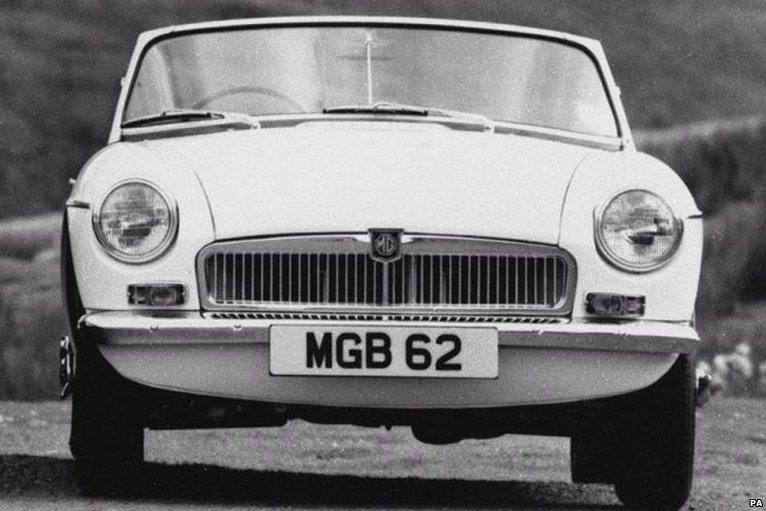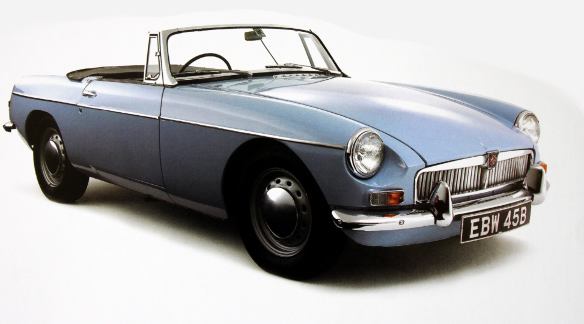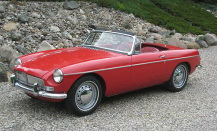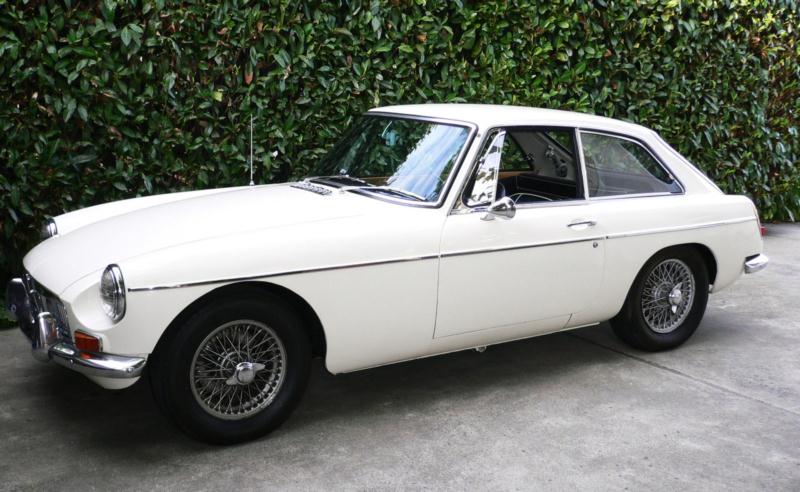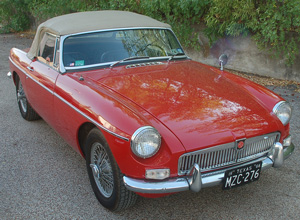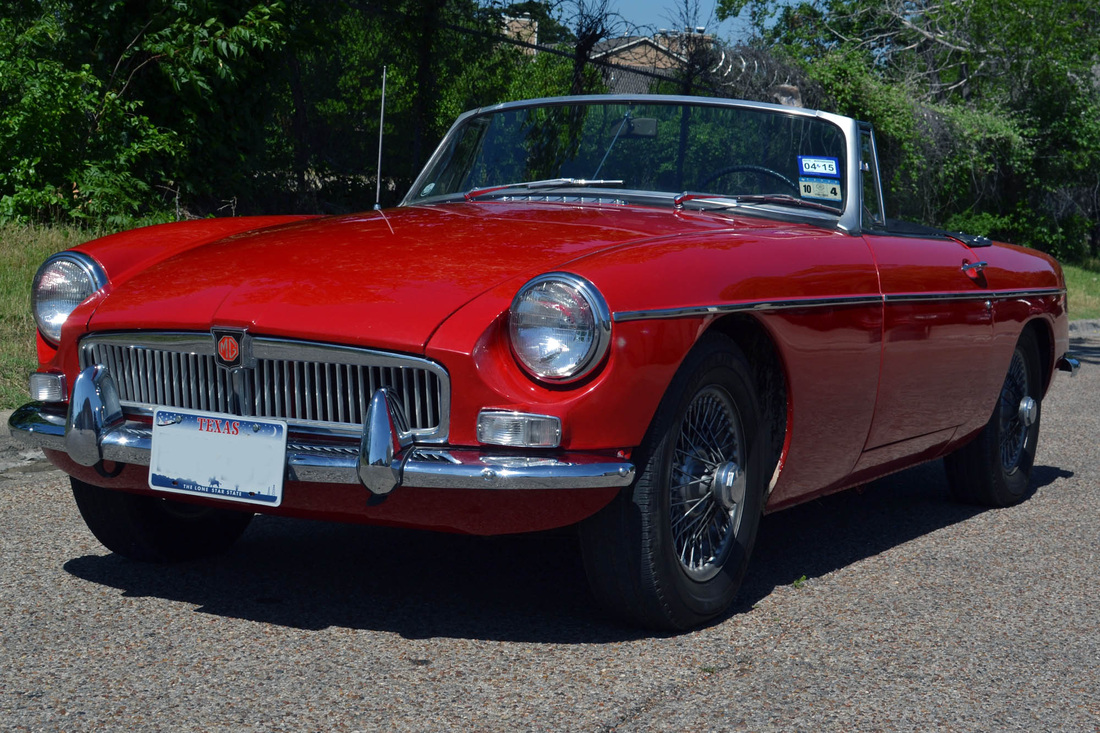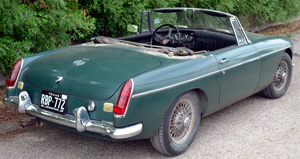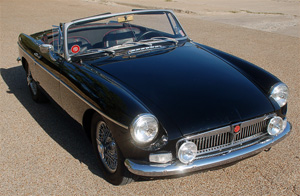MGB Buyers GuideManufactured from 1962 to 1980 by the British Motor Corporation and later British Leyland, the MGB is considered by many to be the ideal English sports car. With more than 500,000 produced they were certainly popular in their day and time has shown both the roadsters and the grand touring "GT" models to have enduring appeal.
Engine The MGB's four-cylinder engine is well-proven and sturdy. At 1798cc, or commonly rounded up to 1800cc, up to the early-1970s the engines produces 95hp. Potential buyers should know that the MGB was never intended to go particularly fast. Expect 0-60 times to be in excess of 10 seconds and a realistic top speed peaking around 90mph (with overdrive transmission). Speed and power is not the point of an MGB. The car is best experienced cruising in the 40-60mph range on bendy side roads with a nice breeze. At idle, audible rocker noise from the top end of the engine is normal. Rumbling from the bottom end means a worn crank and main bearings. A chattering timing chain is worn, but easily and inexpensively replaced with the non-interference engine still in the car. The presence of water in the oil is a sure sign of a blown head gasket and potentially a cracked or warped head. If the oil inside the valve cover is frothing at idle this indicates severe bore and/or valve guide wear. Oil leaks are commonly found near the timing chain cover, gearbox bell housing cover, drain hole, and tappet side covers. When on the road, you’ll want to look for proper oil pressure – 50psi in 4th gear with the engine warm. A significantly lower reading might mean a faulty oil pressure sending unit, a worn oil pump, or worn engine bearings. Running hot indicates a worn water pump, a blocked radiator, or even burned exhaust valves. The safest bet is to have a professional shop replace an entire worn MGB engine with a rebuilt unit. A properly rebuilt and installed MGB engine will last you quite a while when properly maintained – easily 100,000 miles. If you are interested in power tuning your MGB, you may find this well-written guide to be helpful. The additional publications listed in the left column will also help you make an educated purchase and keep your MGB running its best. Transmission and Drive Train MGBs used a three synchromesh transmission up to and including the 1967 model year and this unit is most likely to give trouble as it is less robust and spares parts are hard to find. On all MGB transmissions, noises and grinding are caused by worn bearings, gear teeth, or thrust washers. Also look for the gear lever jumping out of second or third gear when the clutch is not engaged. More than an inch or so of play in the clutch pedal indicates a worn master or slave cylinder that will require immediate replacement. Clutch replacement is best accomplished through the removal of the engine and transmission. Not an easy task to do on your own at home! Faulty overdrive transmissions may be suffering from a clogged filter, low transmission fluid level or a number of electrical issues. If early overdrive transmissions fail to come in or out of third or fourth gear, a worn solenoid switch may be the culprit. The rear axle on an MGB can leak to due faulty seals, a clogged vent, or just careless overfilling. A slight clonking as the axle is engages is actually acceptable, but excessive noise will require attention to the rear differential. Worn halfshafts can be detected by coming on and off the power several times at about 30mph listening for excessive clonking from the rear end. You should also check the u-bolts for tightness. Loose u-bolts will cause the rear end to wander on turns. Be sure to also check the leaf springs for signs of wear, sagging, or even cracking. Suspension and Steering The best indicators of front suspension wear are excessive body lurch on corners and a tendency for the car to generally wander. Bounce the front end of the car above each front wheel to test the strength of the hydraulic dampers. It’s also a good idea to jack up the front end and spin each front wheel to check for problems with wheel bearings. At this time you should also rock or shake each wheel in a vertical plane to check for work kings pins. At the steering wheel there should ideally be no more than one inch of play with the car stationary. More play than this indicates a worn steering universal joint. If the steering doesn’t center while at speed, the king pins are likely to blame. When inspecting wire wheels, look for loose or broken spokes. While a professional can tighten loose spokes, broken spokes are best addressed by replacing the entire wheel with a good used or new aftermarket wire wheel. Wire wheel and hub splines must also be inspected for wear. Worn splines are indicated by clonking at the wheels at acceleration. Of course extremely work splines mean you are going nowhere fast! MGB steel wheels, often referred to as rostyle wheels, require far less maintenance and are practically indestructible. The intricate painted pattern is often faded or marred in a misguided attempt to repaint the wheel. Paint templates are available to make painting easier, but the best bet it to take the time to carefully clean and mask off the pattern and then prime and repaint. It’s well worth the extra effort—and you can be assured that your fellow MGB enthusiasts will notice the time you’ve spent. Early MGBs had a simple steel wheel and small hubcap that, while difficult to find, are fairly easy to maintain. Brakes Worn brake pads and shoes or seized calipers can cause an MGB to pull to one side during braking. Worn rotors can be turned or replaced at minimal cost. In fact all of the mechanical braking components are relatively inexpensive and readily available. Check for a faulty hydraulics by repeatedly depressing the brake pedal and seeing if the pedal eventually goes all the way to the floor. Brake master cylinders can be rebuilt, but it maybe worth having a professional do the job since brake fluid is your paint jobs absolute worst enemy. If the brake warning light comes on when the brake pedal is depressed as hard as possible, the rear brakes are likely leaking at the wheel cylinders. In some instances oil from the rear differential can contaminate the rear brake drums if the rear end is not properly maintained. In this situation a complete brake rebuilt on the rear end is required and the breather on the rear axle should be cleaned and/or replaced. Body The MGB’s sheet metal is basically well built and designed, but any steel-bodied car is prone to rust, particularly in regions with extreme winter weather. The sills (lower interior body area between wheels) provide most of the MGB’s structural support and serious rust problems here go beyond cosmetic issue and become a question of safety. Extremely rotten sills can cause an MGB to actually sag in the middle. A good way to check for this is to look at the vertical door gaps. If the gap is tight at the top and wide at the bottom a problem is indicated. This is a particular problem for MGB roadsters as they have no fixed roof for addition strength and support. Rusted sills should not necessarily be a death sentence for an MGB, but they should only be repaired by a professional. The front fenders rust at the base next to the sill. Rust will often appear around the wheel arches and at the point where the fenders meet the main part of the body. Rust also occurs at the inner portion of the fenders an don the front apron under the bumper. Doors can rust badly along their bottom edges. Another flaw to look out for is the “crack of doom” a crack in the door that appears just under the quarter-window due to a structural design flaw—and the tendency of drivers to pull on the quarter window when closing the door. You must also take the time to examine the underside of the car and the floorboards, especially below the dash. Many owners of MGBs allowed rain to fall inside their cars thinking the process of evaporation would deal with the moisture. Not true! The moist conditions tended to remain under the factory-installed mats staying there until floorboards rotted through. Also pay special attention to jacking points and suspension mounting points. At the rear of an MGB the fenders tend to rust where the inner and outer fender meet and where the sheet metal is beaded at the top of the fender. Rust often appears at the base of the tail lamps as well as inside of the trunk.. Check the trunk floor and lid—rust often appears near the trunk lid supports and around luggage racks. An obvious sign of damage to a trunk lid is a crimp in the metal near the support where a previous owner improperly attempted to close the trunk without depressing the latch on the support first. Fortunately since the late 1980’s brand new body panels--in fact a brand new MGB body shell--can be purchased from UK distributors. These body parts utilize the original tooling from the MGB factory so, while more expensive, the will ensure the best fit and finish. Less expensive aftermarket body parts are also available from other manufacturers and sometimes you can get lucky and find good fenders, hoods, and trunk lids at import salvage yards. You’ll always get what you pay for when it comes to professional bodywork. Ensuring that panels fit correctly and remain aligned requires an experienced touch. Quality repairs are not always inexpensive, but you will appreciate the investment you make in this area each and every time you see your restored MGB. Interior The interior of many MGBs have been neglected or have been subjected to some creative modifications. In the best case your restoration car should have a complete, but well-worn, original interior. In America only early MGBs left the dealers with leather seats. By the late 1968 MGBs had rather poorly executed vinyl seating areas, padded dashes and thin interior panels. Carpeting was also fairly minimal and generally less than luxurious. It’s interesting to compare the differences between US and UK spec MGBs dash boards from 1968-1980. While American cars were fitted with molded padded vinyl dashes, the UK cars kept the original metal dashes with updated gauges, knobs, and switches—much nicer looking, but less safe according to safety experts. On most unrestored MGBs you should expect to spend a considerable amount of time and or money bringing the interior to original (or better) condition. Currently leather seating and panel kits are available as are more plush carpet kits. A quality wood inlay dash kit can upgrade the appearance of US spec dashes, although it will deviate from the original design. You can even upgrade your steering wheel, but remember the factory-installed wheels have a large diameter for a reason—MGBs do not have power steering! An unrestored car is also likely to need a new convertible top. The vinyl tops tend to get torn from improper folding and storage. The top frames are ruggedly designed and even those that do not raise and lower smoothly can be cured with some good lubricant. For just a few hundred dollars you can get a new high-quality aftermarket vinyl top with a zip out rear window. Only those with experience and patience should install an MGB soft top by themselves. To ensure a quality fit, trust an expert. Which MGB to buy? Good question. Since you’ll be investing a considerable amount of time, energy, and most importantly money in an MGB restoration, it’s important to have an idea of the value of the car when the work is complete. Of course this depends greatly on the quality of the restoration work which is not always proportionate to the amount of money you’ve spent. An unscrupulous mechanic or shop can charge you a fortune and not perform the work correctly or even perform it at all (make sure to get documentation and receipts for all work done). In general chrome bumper MGBs (1963-1974) with overdrive transmissions remain the most sought after and therefore hold the highest value. Furthermore, they tend to increase in value at a higher rate than the later rubber bumper MGBs. Among the chrome bumper cars the earliest years 1963-1965 tend to be the most valuable. These early MGBs are terribly simple machines with little or no add-ons to the engine like pollution control or suspect British Leyland “technology”. Early MGBs are considered to be the true essence of the car without pin striping, safety bumpers, or even a radio! The styling treatment of the grilles on chrome bumper MGBs evolved from 1963-1974 from vertically slatted grills, to recessed grills and culminating with a rather cheaply manufactured black egg crate grill. People have their own personal preferences with respect to grills, but make sure to keep it original as an incorrect grill on your MGB will draw criticism from enthusiasts. The chrome bumpers themselves also underwent minor changes with different overriders added and even a split rear bumper on 1970 models. While just a subtle variation on the theme, the split rear bumper is generally considered desirable and enthusiasts actively seek out these cars. Less desirable are the large black overriders that were mounted to 1974 MGBs just prior to the change over to all rubber front and rear bumpers. These are easily removed and replaced with chrome overriders or none at all. 1975-1980 MGBs are easily identified by the controversial black rubber bumpers on the front and the rear of the car. 1975 MGBs are considered by some to be the low point for the model. The execution of the heavy steel reinforced bumpers was not initially well thought out and threw the balance of the car off; made worse by the lack of suspension sway bars. By 1976 they had finally gotten it just about right and 1977 cars also feature an updated more modern dash layout. However pollution control equipment was strangling the little four-cylinder engine further limiting performance. In 1979, the MGB Limited Edition model was offered with special body striping, alloy wheels, and subtle interior upgrades. Of all the rubber bumper cars, this is probably the one to look for. MGBGTs are also wonderful variations on the MGB theme. They offer all the pleasure of driving the classic car with better protection from the elements. Often the interiors of GT models are better preserved so restoring one could save a the owner some money. If you live in a warm climate, be careful because they can get toasty in July! The fact is that the right MGB is a personal decision. Is the car intended to be a casual weekend toy, a show stopper, or an investment? There is a range of MGBs available to satisfy just about everybody! |
Essential reading for buyers and owners includes:
|
